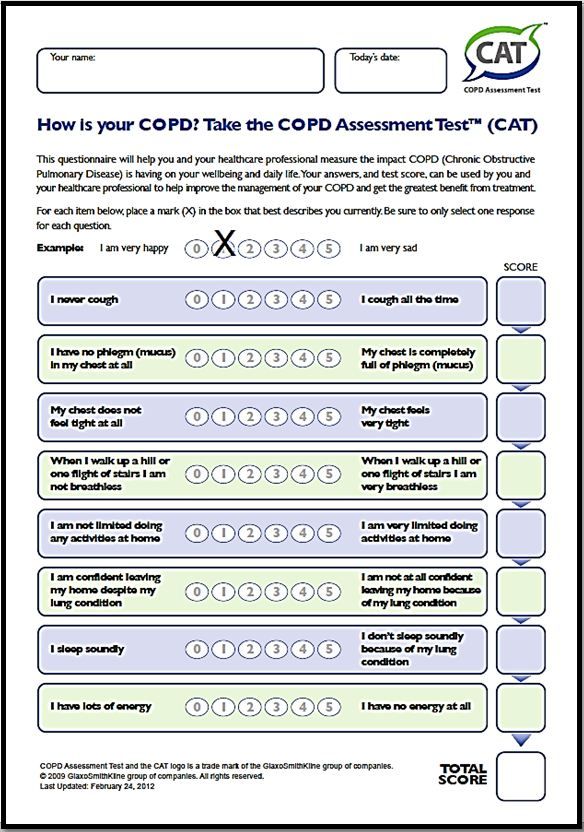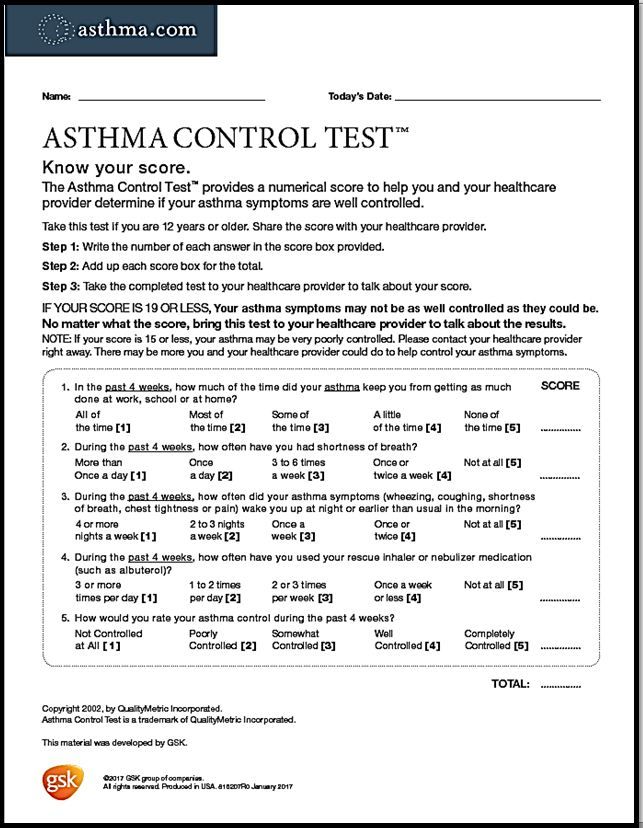- Clinical Technology
- Adult Immunization
- Hepatology
- Pediatric Immunization
- Screening
- Psychiatry
- Allergy
- Women's Health
- Cardiology
- Pediatrics
- Dermatology
- Endocrinology
- Pain Management
- Gastroenterology
- Infectious Disease
- Obesity Medicine
- Rheumatology
- Nephrology
- Neurology
- Pulmonology
Progressive Dyspnea & Chronic Cough: One Disease or Two?
Beth is age 52, smokes 2 packs of cigarettes a day, gets breathless in cold weather, and has had "bronchitis" twice this year. What's your diagnosis?
Figure 1. (Please click to enlarge) ©2009 GlaxoSmithKline group of companies.

Figure 2. (Please click to enlarge) ©2002, by QualityMetric Incorporated.

Figure 3. (Please click to enlarge)

Beth is 52-years-old and comes to your office with worsening respiratory complaints. Beth currently smokes approximately 2 packs per day. She started smoking at age 16, and gradually increased the number of cigarettes she smoked, so that by the time she turned 21, she was already at 1.5 packs per day. She has had progressive dyspnea over the past year and has difficulty playing tennis now with her friends.
She reports a strong allergic history, and notes seasonal allergies: she can’t visit her friend at her home because of her cat. Her symptoms of breathlessness, wheezing, and cough seem to be worse in the cold air and often wake her up at night. She describes a chronic cough of white phlegm, although she often develops “bronchitis,” particularly during the winter months, with green phlegm, and worsening dyspnea and cough, which needs treatment with an antibiotic and sometimes a short course of steroids. This has happened twice over the past year.
She remembers that she had mild asthma as a child and took allergy shots, but seemed to “outgrow” those symptoms as a teenager. Her daughter has asthma, and she has been using her daughter's short acting beta agonist reliever medication almost every day, and once a week at night for relief.
Questions:What is the leading differential diagnosis? Asthma? COPD? Something else? There is considerable diagnostic uncertainty at this point. The patient has a long smoking history, consistent with COPD. She has progressive, chronic respiratory symptoms, including a productive cough, both uncommon in asthma, and common in COPD. She has infectious exacerbations, also common in COPD and uncommon in asthma. However, she seems to have variable symptoms which get worse at night, with cold air, and with exercise, common in asthma, uncommon in COPD. She has a strong history of allergic rhinitis, and a possible history of childhood asthma, both favoring a diagnosis of asthma, not COPD.
Physical Exam:T: 98.6 P: 70 R: 14 BP: 120/80
Lungs: Decreased breath sounds, prolonged expiratory phase, mild wheezing bilaterally
Assessment: Possible COPD, possible asthma, ?mixed
You then administer two standardized tests: the COPD Assessment Test (CAT) for COPD1 (Figure 1, above) and the Asthma Control Test (Act) for asthma,2 (Figure 2, above). Her CAT score is 15, indicating symptomatic COPD; (higher than 10 is usually considered the cutoff). Her ACT score is 16, suggesting poor control of asthma; (19 or less is usually considered the cutoff).
Spirometry is then performed before and after bronchodilator administration. Results are seen in the table in Figure 3, above.
Next: Can you make a diagnosis now?
More QuestionsDo the questionnaires, and physical exam or spirometry help in determining the diagnosis? What should be done next?
The questionnaires and physical exam don’t seem to help narrow the diagnosis. Beth seems to have highly symptomatic COPD, or poorly controlled asthma by questionnaire. Wheezing can be present in both conditions, and while decreased breath sounds would be more common in COPD than asthma, it is really not that helpful, as asthma with hyperinflation could also lead to this finding. The spirometry is useful, as that vigorous a bronchodilator response would be uncommon in COPD.
What should be done next?
A. Treat for COPD
B. Treat for asthma
C. Who cares, just pick a bronchodilator and call it asthmatic bronchitis
D. Refer to specialist for further testing
You decide to refer Beth to a pulmonologist for further testing. The pulmonologist gets a diffusing capacity, which is mildly reduced, and an eosinophil count, which is elevated at 300 cells/uL. He diagnoses Beth with asthma/COPD overlap (ACO) syndrome.
How should Beth be treated?
The pulmonologist talks to Beth about the importance of smoking cessation. She has no contraindications, and so agrees to a trial of Chantix (varenicline). He ponders the pharmacologic treatment of her ACO. If she were diagnosed with COPD, according to the current GOLD (Global Initiative for Chronic Obstructive Lung Disease) guidelines,3 she would be Group D.
The preferred treatment for Group D is a combination long-acting muscarinic antagonist and long acting beta agonist (LAMA/LABA). However, if he were to treat Beth according to the current GINA (Global Initiative for Asthma) guidelines,4 he would be unable to initially classify severity, as Beth hasn’t been on any controller medication. In view of her abnormal lung function and persistent symptoms, the pulmonologist decides that Beth must be at least a step 3, for which the preferred treatment is a combination of a low dose inhaled steroid and a long acting beta agonist (ICS/LABA), as shown:
Next: Now, how should Beth be treated?
How should Beth be treated?
A. According to the GOLD guidelines with LAMA/LABA
B. According to the GINA guidelines LABA/ICS
C. Combine the guidelines and treat with LAMA/LABA/ICS
D. Something else?
There are no absolute guidelines to answer this last, but probably most important, question. Even the definition of ACO has not been fully accepted as yet. However, there are some important principles that should guide the clinician on treatment. The first is that inhaled corticosteroids are the mainstay of treatment in asthma. It is an inflammatory disease, and almost always responsive to this class of medication. Secondly, LABAs can be dangerous in the treatment of asthma, particularly when given without concomitant inhaled steroids. Thus, treating Beth with a LAMA/LABA is probably not a good idea. Triple therapy, with a LAMA/LABA/ICS, may be effective, but may also be unnecessary and expensive.
The clinician decides to treat Beth with a low dose ICS/LABA and reassess in a month or two. He knows that if her symptoms remain poorly controlled, he can step up therapy by increasing the dose of the ICS, or adding a LAMA.
References:
1. COPD Assessment Test.Accessed March 1, 2018.
2. Asthma Contorl Test. Accessed March 1, 2018.
3. Gold 2017 Global Strategy for the Diagnosis, Management, and Prevention of COPD. Accessed March 1, 2018.
4. Global Initiative for Asthma. Accessed March 1, 2018.
Kymera's Oral STAT6 Degrader KT-621 Shows Biologic-Like Activity in Early Atopic Dermatitis Trial
December 8th 2025KT-621 achieved deep STAT6 degradation and strong 4-week EASI and itch reductions, offering a potential new oral option for moderate–severe AD and other Th2 inflammation-driven disease.
